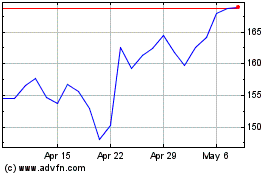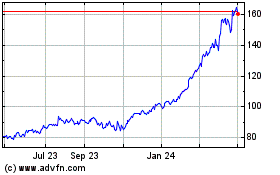General Electric Has a Long-Term Care Problem. It Isn't Alone
October 23 2017 - 5:59AM
Dow Jones News
By Leslie Scism
Worries about the health of the long-term-care insurance
industry have nettled investors for years. General Electric Co.'s
comments show the problem isn't going away soon.
The Boston company on Friday cut its earnings forecast for the
year, citing poor results at units including its power division.
The company also said results could be hit by a reassessment of an
insurance unit's prospects -- a remark that came as a surprise to
some, given that GE years ago spun out a business closely
identified with long-term care, now known as Genworth Financial
Inc.
A GE executive on the company's conference call Friday morning
said the firm has actuaries combing through its long-term-care
insurance reserves in "a very complex exercise" to figure out if
they are deficient.
GE still has billions of dollars in reinsurance obligations on
its books from coverage it sold to other insurers that had sold
policies to consumers. By doing so, GE took on some of those
carriers' responsibilities for paying claims, according to
analysts. The risk for GE and others is whether carriers that sold
long-term care policies have adequate reserves to pay future
claims.
Until the review is completed, GE is halting dividends from its
GE Capital unit to the parent, which has fueled concerns about
whether the company will maintain its common-stock dividend. GE is
aiming to conclude the review before year-end.
If GE proceeds with an outsize charge, it "may result in a
negative read across" a wide range of other companies with
long-term-care reserves, said analysts at securities firm Evercore
ISI in a recent report. Their report followed GE's disclosure this
summer of the review, when it noted "adverse claims
experience."
Evercore said long-term-care is "one of the larger balance-sheet
concerns" at insurers including Genworth, Manulife Financial Corp.
and Unum Group. The three companies declined to comment.
Evercore said its analysis of GE's regulatory filings indicates
the company likely has "a deficiency of 20% or more" in its
long-term-care reserves, which could mean a charge of $2.5 billion
or more.
Long-term-care insurance took off in the early 1990s. The
policies had strong appeal to older people, and many insurers
thought they had the perfect product to profit from people's
concerns about becoming unable to care for themselves and outliving
their savings.
In general, the policies pay for nursing homes, assisted living
facilities or health-care aides in people's private residences.
Such care generally isn't paid by the Medicare health-insurance
program for older people, while the state-federal Medicaid program
is for the poor.
Some early versions of long-term-care policies provided lifetime
benefits.
But by the mid 2000s, many insurers were rapidly ratcheting back
the benefits, concluding they had badly miscalculated how many
people would file claims and how long they would draw benefits
before dying, among other things.
Many insurers have obtained regulatory approval for double-digit
premium-rate increases on existing policyholders. Insurers say that
even those increases generally fall short of what is needed to
bring their older books of business back to break even in
profitability.
Industrywide, insurers have taken billions of dollars of charges
over the past decade. Genworth, which was spun off from GE in 2004,
has tallied losses from its older long-term-care policies of $2.5
billion since 2006.
GE assumed the liabilities it now is analyzing through a series
of reinsurance agreements, Evercore said. GE quit selling
reinsurance policies some years ago.
GE said Friday that its long-term-care reserves total about $12
billion, about half of its total insurance reserves.
Evercore said its analysis of GE's regulatory filings with state
insurance departments showed that claims were running far higher
than GE had expected.
"While this is not the worst block out there, we still view it
as one of the riskier ones given that these policies were likely
written in the late 1980s/early 1990s," Evercore said of one large
part of GE's book of business.
Aside from miscalculations about claims volume, insurers are
also battling the impact of ultralow interest rates. Insurers count
on investing premiums until needed to pay claims, and
long-term-care premiums typically are invested for years, if not
decades, before customers file their claims. Genworth has said it
priced many older policies on the assumption the company would earn
7.5% a year on invested premiums. But new premiums are being
invested today at about 4.25%.
Write to Leslie Scism at leslie.scism@wsj.com
(END) Dow Jones Newswires
October 23, 2017 05:44 ET (09:44 GMT)
Copyright (c) 2017 Dow Jones & Company, Inc.
GE Aerospace (NYSE:GE)
Historical Stock Chart
From Mar 2024 to Apr 2024

GE Aerospace (NYSE:GE)
Historical Stock Chart
From Apr 2023 to Apr 2024
